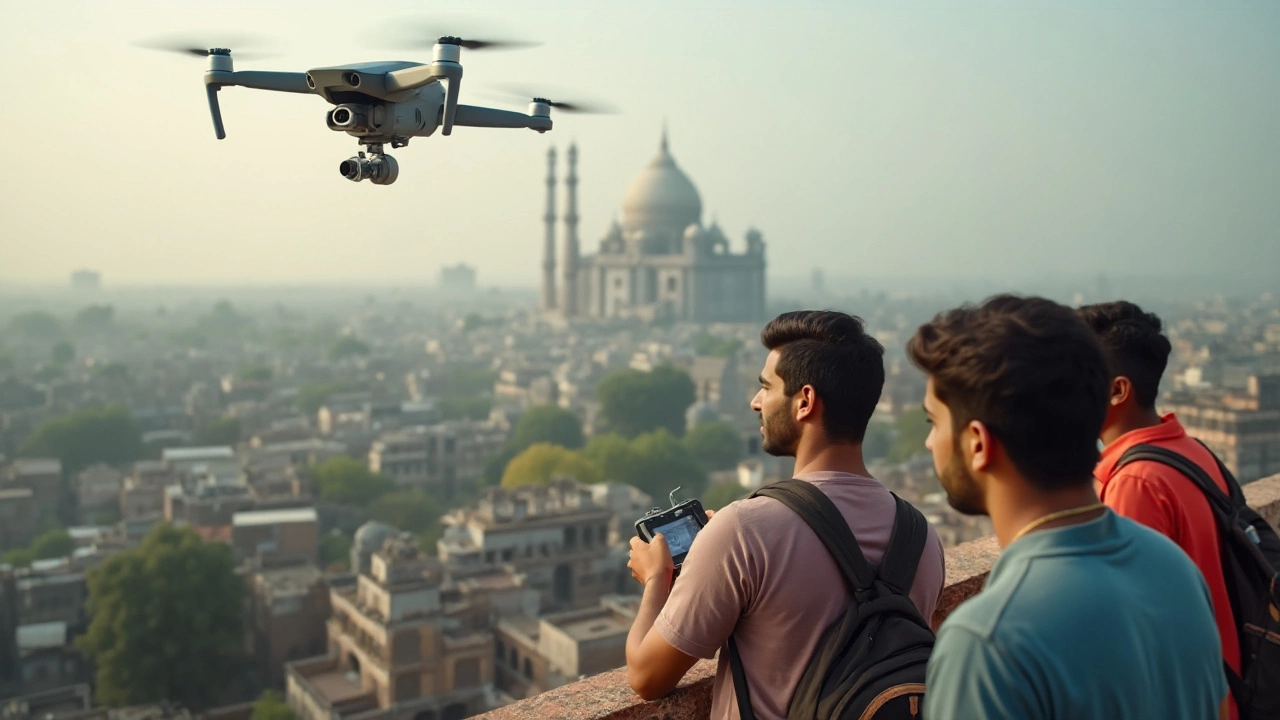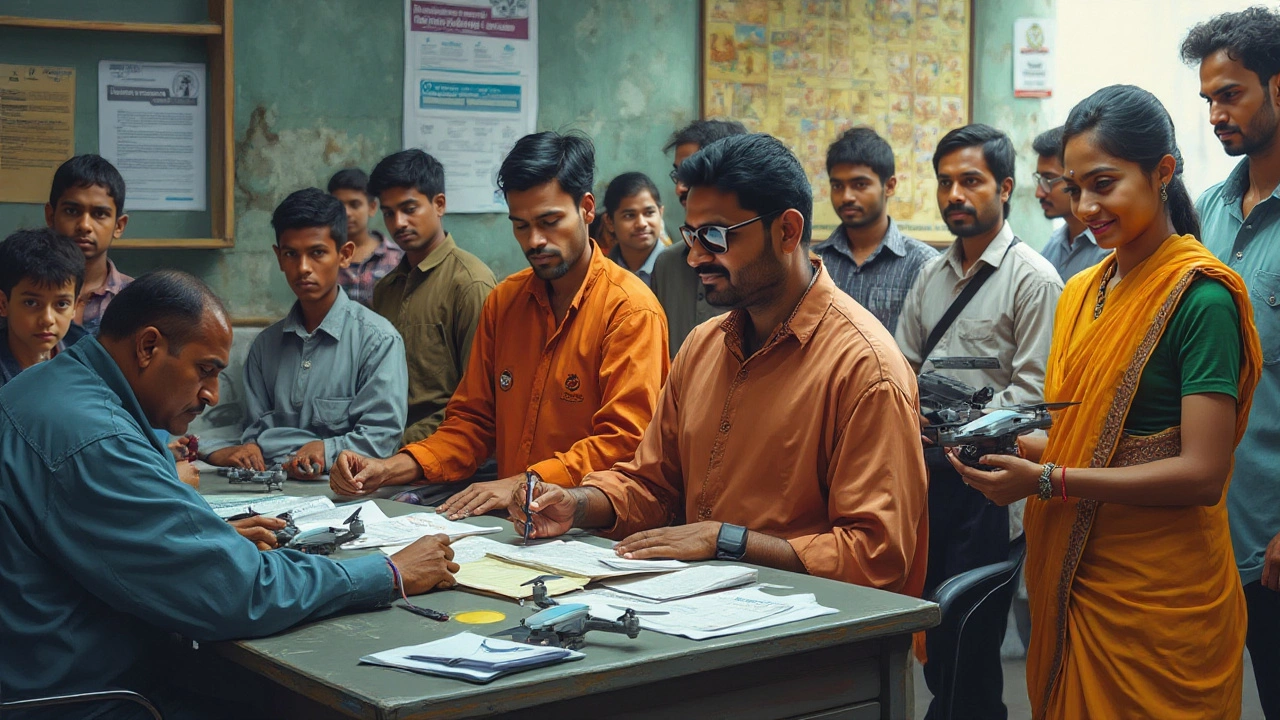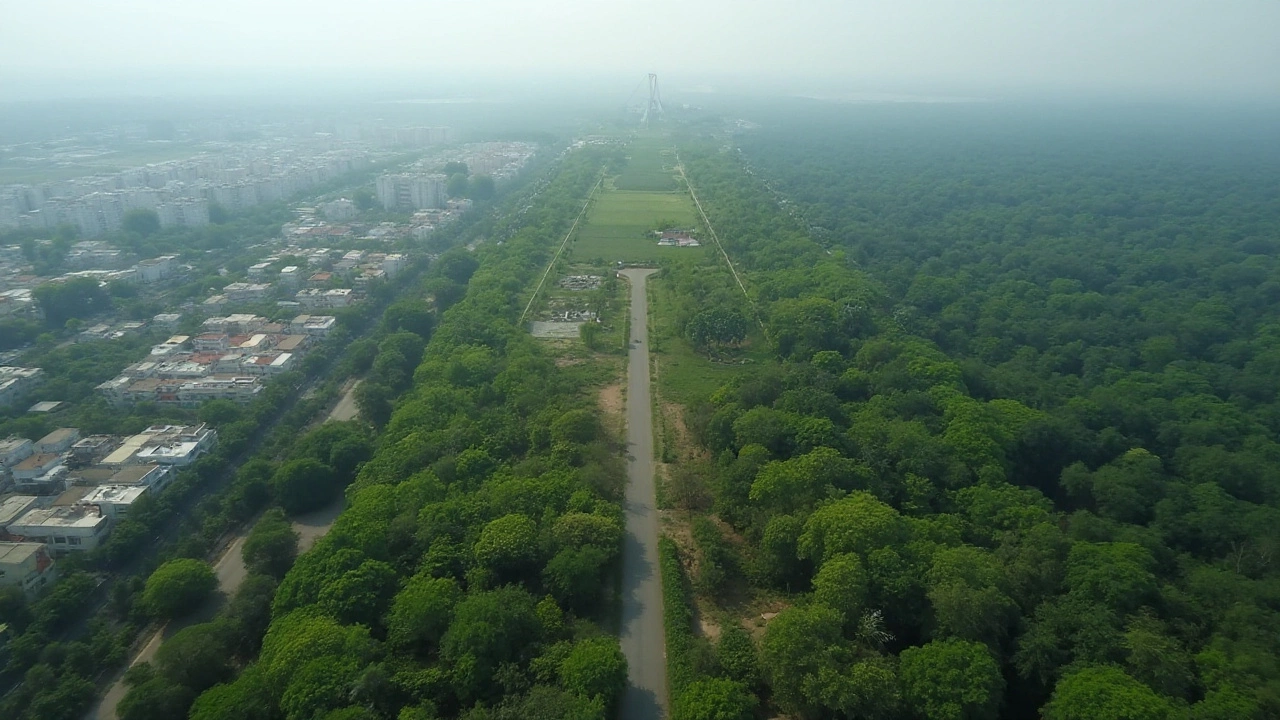Are DJI Drones Illegal in India? Rules and Guidelines for Enthusiasts
 Jan, 5 2025
Jan, 5 2025
Drone enthusiasts in India must navigate a maze of laws and regulations to soar freely. With DJI drones capturing breathtaking views, it’s tempting to take them for a spin above the lush landscapes and historical sites. However, understanding the legality is crucial to avoid landing in hot water with the authorities.
India's drone regulations are detailed and comprehensive, ensuring that both safety and privacy are protected. The Director General of Civil Aviation (DGCA) plays a vital role in establishing these rules. They've introduced measures aimed at controlling the airspace while encouraging innovation and usage of drones in various sectors.
Being informed about registration requirements and understanding the specifics of no-fly zones are just as important as mastering drone piloting skills. Join us as we delve into the nitty-gritty of flying DJI drones in India, and discover the beauty of drone photography without stepping on legal toes.
- Current Drone Laws in India
- Registration and Permissions
- No-Fly Zones and Restrictions
- Drone Photography in India
- Safety and Privacy Concerns
Current Drone Laws in India
The landscape of drone regulation in India has evolved dramatically over the past few years, guided by the country's aspirations to integrate drones into both commercial and recreational spaces. Established by the Directorate General of Civil Aviation (DGCA), the regulatory framework sets the stage for what is permissible when it comes to flying DJI drones in India. It's critical to understand these laws to enjoy your aerial adventures without breaching the legal boundaries set by the authorities.
A pivotal moment was the release of the Civil Aviation Requirements (CAR) for drones, which sought to standardize and simplify the use of drones in India. The DGCA dictates that all drones must be registered, and owners must secure an Unmanned Aircraft Operator Permit (UAOP) for operations. This registration process involves submitting detailed information about the drone's specifications, its intended use, and personal information of the operator. As of recent updates, micro drones used for non-commercial purposes may require fewer hurdles, illustrating an effort to encourage recreational flying while maintaining oversight.
Drone regulations in India also emphasize the importance of adhering to prescribed airspaces. No-fly zones are clearly demarcated, including areas around airports, military facilities, and international borders. The Indian government has established a digital platform known as the Digital Sky to aid drone operators. This interactive platform provides real-time permission for flying in specific zones and is part of India's Digital India initiative, aiming to streamline permissions and provide clarity on boundaries. Operators must apply for permission each time they plan a flight, which is then approved or declined based on air traffic and other considerations.
Ankit Mehta, chairman of the Drone Federation of India, noted, "India's approach to drone regulations is comprehensive yet adaptive, balancing innovation with safety. The introduction of the Digital Sky platform marks a progressive step towards encouraging drone innovation while ensuring the safety of our airspace."
The regulations have also seen advancements with regard to integrating drones into India's industrial and commercial sectors, including agriculture, real estate, and media. It's worth noting that the government is consistently revisiting these laws to accommodate technological changes and the growing appetite for drone applications. In addition, the emphasis is placed on ensuring that drone usage does not infringe on the privacy or safety of individuals. Any breach of privacy or unlawful surveillance using drones is a serious offense under Indian privacy laws.
Drone photography enthusiasts in India are encouraged to stay updated with these evolving laws to avoid fines or legal consequences. While the legal landscape can seem daunting, India’s regulatory framework for drones represents an exciting opportunity for hobbyists and professionals alike to partake in this high-flying arena. Those interested in exploiting the limitless potential of drones should arm themselves with this knowledge, ensuring their passion and respect for the law coexist harmoniously.
Registration and Permissions
Flying DJI drones in India is an exciting way to capture the country's vivid landscapes from above, but it's important to take note of the registration and permissions required by Indian authorities. Navigating through the official maze can be challenging, but understanding the rules laid out by the Directorate General of Civil Aviation (DGCA) is crucial for staying on the right side of the law. First, potential drone pilots must start by registering their equipment. The DGCA portal Digital Sky empowers users to register their drones online, ensuring a streamlined process despite the bureaucracy involved. Such registration not only legitimizes your flying activities but also aligns with national safety standards.
Registering a drone isn’t as simple as just filling forms. It necessitates your drone having a unique identification number that is provided upon successful registration. In India, drones are categorized based on their weight—from Nano drones, which are less than 250 grams and don't need registration, to heavier categories which require both registration and permission before flight. A unique feature of the Indian drone regulations is the ‘No Permission No Takeoff’ (NPNT) rule, which essentially makes it imperative for drone operators to get permission through a mobile app each time they wish to fly a drone weighing over 250 grams. This is an essential layer of precaution put in place to ensure the airspace remains safe for commercial and private air travel.
Here's where it gets even more interesting: achieving a perfect registration doesn’t end with numbers and applications. For foreign nationals keen on experiencing drone photography in India, they might face stricter rules and additional steps. While they can bring drones into India, flying them would require them to lease the drones to an Indian entity which then registers it accordingly. Moreover, the DGCA mandates real-time tracking features in most drones that ensure that operators adhere to designated corridors and avoid flying over aggregations of people, sensitive structures, and places of strategic importance. Rational measures are performed to avoid intrusion into privacy and maintain navigational safety. Industry leaders and hobbyists have opined in several forums how these rules have balanced safety and innovation.
Sanjay J, a prominent voice in the aviation industry, mentions, "The drone ecosystem is thriving, thanks to a structured approach to regulation, which seeks to protect privacy while opening doors for technological advancements."
Understanding where and how to get flying approvals takes precedence among enthusiastic beginners. The application process often requires key details like the drone's make, model, and purpose of use. Once submitted, verification might take a few days, depending on factors such as the operator’s location and their status with DGCA. Once approved, it’s important to download the permission letter, as this indicates that your flight is legally authorized. This letter could be mandatory to present during random checks or when questioned in restricted zones—something that shouldn't be taken lightly if one is looking to avoid hefty fines and penalties. Drone operators often share insights and experiences on platforms like social media or dedicated forums, offering community-driven support for smoother registration experiences.
Given the complexity and the fast-evolving nature of drone regulations in India, drone operators are advised to keep abreast of any changes in the DGCA guidelines. Regular updates and guidelines on the DGCA website provide invaluable insights for modern UAV operators. Ensuring that paperwork is complete and up-to-date before taking on a drone flying session is just as exhilarating as taking stunning aerial shots, as it reflects preparedness and respect for aviation laws. This due diligence not only assures an engaging drone flight but also ensures the safety of others using the airspace.

No-Fly Zones and Restrictions
When it comes to flying drones in India, understanding no-fly zones is absolutely crucial. The Indian government has set clear guidelines to ensure public safety, protect privacy, and prevent interference with manned aircraft activities. One of the most important stipulations is the restriction around airports. Flying drones within 5 kilometers of an airport is strictly forbidden unless special permissions are granted. This rule is in place to avoid any potential collision risks with airplanes during takeoff and landing. Additionally, drone laws in India prohibit flight over military installations, as national security is a top priority.
It's fascinating to note how drones are also banned around government buildings and strategic locations, which includes embassies and international borders. These areas are considered sensitive due to the risk of espionage and unauthorized surveillance. Interestingly, drone enthusiasts must also avoid flights over densely populated areas and gatherings. This is because a malfunction or misstep in a crowded place can result in injuries or more significant consequences. Maintaining a safe distance from these areas minimizes the risk and ensures that people on the ground feel secure.
If you're planning to capture breathtaking shots while flying DJI drones, you'll need to be aware of wildlife sanctuaries too. Drones can disturb the natural habitat and behavior of wildlife, which is why flying within certain sanctuaries can be heavily restricted. It’s wise to research any local or wildlife laws before heading out for drone photography. Additionally, urban environments may have their own peculiar regulations, especially if they serve as important economic centers. Every city has its own unique landscape of concerns and constraints to consider.
"The rapidly advancing technology in drones has necessitated robust regulations to ensure safety and security," says the DGCA, in its official guidelines on drone operations. "The spatial dimension of drones poses a unique challenge for policy-makers, which requires comprehensive understanding by users."
It's critical to understand that these restrictions derive from the need to balance technological innovation with societal concerns. Navigating these regulations can seem daunting at first, but they are essential for sustainable drone use in India. Ensuring you understand the regulations not only protects you legally but also upholds public trust in this exciting technology. For those looking to push creative photography boundaries, knowing where you can and can't fly will help you operate within the law and make the most of your flights while exploring India’s stunning terrains.
Drone Photography in India
Drone photography in India is an exciting and rapidly growing field, offering unique aerial perspectives of the country's diverse landscapes. From the verdant tea gardens of Assam to the historic forts of Rajasthan, drones have opened up new vistas for photographers. As the technology becomes more accessible, more creators are exploring these opportunities. Yet, with great opportunities come responsibilities, as photographers must adhere to complicated regulations to ensure safety and compliance with the law. The use of drones for photography has become popular for weddings, real estate showcases, and even tourism promotions, showcasing breathtaking sceneries from previously unattainable heights.
The Indian government recognizes the potential of drone technology, paving the way for increased creativity in various sectors. However, regulations have been put in place to ensure safe usage. Those interested in engaging in drone photography must ensure their devices are registered and users have the necessary permissions. This process can be intricate but ultimately rewarding. For instance, to legally operate a drone in India, it must be registered with the DGCA, and the operator must obtain a Unique Identification Number (UIN) and an Unmanned Aircraft Operator Permit (UAOP) if required. These permits are particularly important for surveillance and commercial use.
"Aerial photography allows for new creative angles that can dramatically enhance a story or convey a message that would otherwise be inaccessible," explains renowned photographer Ravi Kumar.
It's important for drone operators to stay informed of the zones that they are legally allowed to fly in. Large swathes of airspace are marked as no-fly zones, including areas near military installations and certain urban regions. However, popular tourist areas often offer opportunities for licensed drone operations. The Indian government has laid out a Digital Sky platform, which is an online system for registering drones, seeking permissions, and locating fly zones. Safety concerns are paramount, particularly in crowded areas or near airports, where drones could pose significant risks.That’s why it's crucial for operators to check the current status of their flying zones before embarking on their photographic journeys.
Legal Considerations for Drone Photography
Regulations aside, ethical considerations play a role in drone photography. Privacy concerns are becoming increasingly important, as drones have the potential to intrude upon personal space. Operators are encouraged to be mindful of these concerns and avoid capturing images that invade privacy or cause distress. Furthermore, respect for wildlife and the environment is essential, as drones can disrupt habitats or scare animals. The Ministry of Civil Aviation urges operators to follow guidelines that protect both people and nature. Violations can result in fines or legal action, emphasizing the need for responsible usage.
The costs associated with drone photography can vary widely, depending on the equipment and permits required. However, the investment often pays off for enthusiasts and professionals alike, opening doors to innovative projects and collaborations. There are also numerous workshops and online resources available, aimed at helping photographers hone their skills in this burgeoning field. By staying informed and respecting regulations, drone photography enthusiasts can continue to explore India's stunning landscapes and document them from captivating, fresh angles, contributing to the rich tapestry of visual media in the country.

Safety and Privacy Concerns
When it comes to flying DJI drones in India, safety and privacy are crucial aspects that enthusiasts cannot ignore. The lure of capturing unique aerial footage can sometimes overshadow the need for responsible drone usage, which is why understanding these concerns is vital. Privacy issues can emerge as a key challenge in today’s digital age, especially with high-definition cameras capable of capturing detailed images from afar. Instances of drones navigating into restricted airspace or unintentionally capturing private property or individuals are not merely hypothetical; such incidents have been documented globally, leading to public outcry and demands for stricter regulations.
The Indian government has proactively addressed these worries by implementing measures aimed at ensuring that drone operators can enjoy their hobby while upholding privacy rights. The Digital Sky Platform is a notable initiative allowing seamless integration between drone pilots and regulatory bodies. This framework requires pilots to upload flight details, enforce tracking, and monitor airspace traffic.
The DGCA has stated, "Our goal is to strike a balance between technological advancement and safeguarding individual privacy."This expresses the commitment to retaining individual rights alongside embracing cutting-edge technologies.
To enhance safety, India has mapped out precise no-fly zones using geo-fencing technology. Geo-fencing ensures the UAVs remain confined to pre-approved areas, avoiding crucial infrastructure such as airports, military installations, and densely populated locales. This blend of GPS, RFID, or Wi-Fi signals effectively prevents accidental breaches, thereby contributing to safer skies. Pilots shoulder the responsibility of respecting these zones for the benefit of everyone.
Privacy invasions aren't the only concerns, though; physical safety is vital too. Ensuring that the drones themselves are mechanically and electronically sound before each flight is a standard yet significant practice. Regular maintenance, proper handling, and adherence to weight categories - all contribute to a safe flying experience. Reports suggest that amateur operators with little practice can become prone to errors, resulting in dangerous crashes. Enabling safety procedures, pre-flight equipment checks, and simulation training, can avoid these pitfalls.
Monitoring air traffic remains central to ensuring drone flight safety. Real-time visibility into airspace activity via dedicated platforms allows both enthusiasts and authorities to track and manage drone operations effectively. A structured approach to sharing the airspace holds promise for a future where UAVs and traditional aircraft operate in harmony without interruptions.
A respectful approach to this hobby not only preserves public trust but also ensures that the craft can be used recreationally and commercially without infringing on others’ lives. It lies with community leaders, like seasoned pilots, to instill a sense of consciousness among newcomers who're eager to launch high-tech drones high into the sky. For those in India and beyond, that's a responsibility worth bearing.